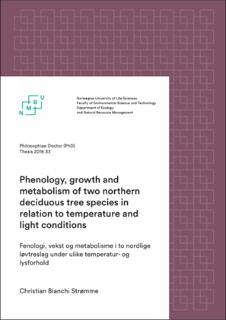| dc.description.abstract | In temperate climates, phenological transitions in tree species allow survival through adverse climatic conditions in winter. Seasonal change is sensed through shifting patterns in daylength, temperature and light quality. With the ongoing rise of global temperatures, there is increased research interest in temperature effects on phenology. Based on evidence from controlled conditions, as well as indications from modelling studies of species distributions, extended growing seasons are expected mainly as a result of advanced spring bud break, and to some extent also through delayed phenological events in autumn. However, temperature effects are still poorly understood when the whole-year cycle of seasonal shifts is considered, and also in terms of interactions with day-length and light quality. The purpose of this thesis was to investigate how temperature and light conditions affect phenological transitions in two deciduous tree species present in Northern Europe. The effects of temperature and Ultraviolet-B (UV-B) radiation on phenological transitions, growth and metabolism were investigated in European aspen (Populus tremula) grown in field conditions. In addition, spring phenology and cold hardiness was studied in European beech (Fagus sylvativa) populations in Norway, which represent the species’ northernmost distribution range. For Eurasian aspen, autumn temperature delayed bud formation in autumn, an effect which was stronger in male plantlets. On the other hand, UV-B had a positive effect on bud formation in autumn, counterbalancing the effect of temperature. Bud break during spring was positively affected by autumn warming, but this effect was marginal compared to the positive effect of spring temperature. For European beech, warming promoted bud break in controlled and field conditions, indicating that bud break timing at the species’ northernmost distribution range is limited by temperature. For both species, it was shown that warming can be expected to extend the length of growing seasons, possibly with increased risk of frost damage. | nb_NO |
